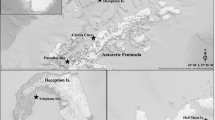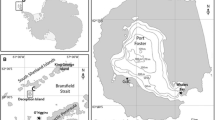Abstract
In the marine environment, any living or non-living surface is exposed to bacterial colonization. Many invertebrate species in temperate, tropical and Antarctic regions have demonstrated chemical defences against the formation of microbial films. In the present study, the antimicrobial activity of sub-Arctic invertebrates was investigated for the first time. Crude extracts of abundant invertebrates belonging to several taxonomic groups were tested for their inhibitory effects on the growth of five sympatric phylogenetically diverse bacterial strains. Six out of 18 (33%) crude extracts inhibited bacterial growth at natural extract concentrations. The crude extract of the sponge Haliclona viscosa inhibited growth of all five bacterial strains, suggesting the presence of metabolites with broad-spectrum activity. Three active compounds were isolated from H. viscosa having antibacterial properties similar to those of the crude extract. Our data indicate that antibacterial secondary metabolites are present in sub-Arctic marine invertebrates but are less abundant than in temperate, tropical or Antarctic species.


Similar content being viewed by others
References
Acar JF (1980) The disc susceptibility test. In: Lorian V (ed) Antibiotics in laboratory medicine. Williams and Wilkins, Baltimore, pp 24–54
Amade P, Charroin C, Baby C, Vacelet J (1987) Antimicrobial activities of marine sponges from the Mediterranean Sea. Mar Biol 94:271–275
Atlas RM, Morita RY (1986) Polar environments. Bacterial communities in nearshore Arctic and Antarctic marine ecosystems. Proc IV ISME
Baker BJ, Scheuer PJ, Shoolery N (1988) Papuamine, an antifungal pentacyclic alkaloid from a marine sponge, Haliclona sp. J Am Chem Soc 110:965–966
Bakus GJ (1974) Toxicity in holothurians: a geographical pattern. Biotropica 6:229–236
Bakus GJ, Green G (1974) Toxicity in sponges and holothurians: a geographic pattern. Science 185:951–953
Bakus GJ, Wright M, Khan AK, Ormsby B, Gulko DA, Licuanan W, Carriazo E, Ortiz A, Chan DB, Lorenzana D, Huxley MP (1994) Experiments seeking marine natural antifouling compounds. In: Thompson MF, Nagabhushanam R, Sarojini R, Fingerman M (eds) Recent developments in biofouling control. Oxford and Ibh, New Delhi, pp 373–381
Barthel D, Wolfrath B (1989) Tissue sloughing in the sponge Halichondria panicea: a fouling organism prevents being fouled. Oecologia 78:357–360
Becerro MA, Uriz MJ, Turon X (1997) Chemically-mediated interactions in benthic organisms: the chemical ecology of Crambe crambe (Porifera, Poecilosclerida). Hydrobiologia 356:77–89
Becker K, Wahl M (1991) Influence of substratum surface tension on biofouling of artificial substrata in Kiel Bay (Western Baltic): in situ studies. Biofouling 4:275–291
Benson DA, Boguski MS, Lipman DJ, Ostell J, Oullette BF, Rapp BA, Wheeler DL (1999) GenBank. Nucleic Acids Res 27:1–7
Bergquist PR, Bedford JJ (1978) The incidence of antibacterial activity in marine demospongiae; systematic and geographical considerations. Mar Biol 46:215–221
Bergquist RP (1978) Sponges. University of California Press, Berkeley
Bolser RC, Hay ME (1996) Are tropical plants better defended? Palatability and defenses of temperate vs. tropical seaweeds. Ecology 77:2269–2286
Brown JW, Kesler CT, Neary JT, Fishman LM (2001) Effects of marine sponge extracts on mitogen-activated protein kinase (MAPK/ERK sub(1,2)) activity in SW-13 human adrenal carcinoma cells. Toxicon 39:1835–1839
Burkholder PR, Ruetzler K (1969) Antimicrobial activity of some marine sponges. Nature 222:983–984
Charan RD, Garson MJ, Brereton IM, Willis AC, Hooper JNA (1996) Haliclonacylamines A and B, cytotoxic alkaloids from the tropical marine sponge Haliclona sp. Tetrahedron 52:9111–9120
Clark RJ, Field KL, Charan RD, Garson MJ, Brereton IM, Willis AC (1998) The haliclonacyclamines, cytotoxic tertiary alkaloids from the tropical marine sponge Haliclona sp. Tetrahedron 54:8811–8826
Davis AR, Targett NM, McConell OJ, Young CM (1989) Epibiosis of marine algae and benthic invertebrates: natural products chemistry and other mechanisms inhibiting settlement and overgrowth. In: Scheuer PJ (ed) Bioorganic marine chemistry, vol 3. Springer, Berlin Heidelberg New York, pp 85–114
Dyrynda PEJ (1985) Chemical defences and the structure of subtidal epibenthic communities. In: Gibbs E (ed) Proceedings of the 19th European marine biology symposium
Elverhoi A, Lonne O, Seland R (1983) Glaciomarine sedimentation in a modern fjord environment, Spitzbergen. Polar Res 1:127–149
Fusetani N, Yasumuro K, Matsunaga S (1989) Haliclamines A and B, cytotoxic macrocyclic alkaloids from a sponge of the genus Haliclona. Tetrahedron Lett 30:6891–6894
Fusetani N, Asai N, Matsunaga S, Honda K, Yasumuro K (1994) Cyclostellettamines A-F, pyridine alkaloids which inhibit binding of methyl quinuclidinyl benzilate (QNB) to muscarinic acetylcholine receptors, from the marine sponge, Stelletta maxima. Tetrahedron Lett 35:3967–3970
Giovannoni S (1991) The polymerase chain reaction. In: Stackebrandt E, Goodfellow M (eds) Nucleic acids. Techniques in bacterial systematics. Wiley, Chichester, pp 177–203
Gosink JJ, Woese CR, Staley JT (1998) Polaribacter gen. nov., with three new species P. irgensii sp. nov., P. franzmannii sp. nov., and P. filamentus sp. nov., gas vacuolated polar marine bacteria of the Cytophaga-Flavobacterium-Bacteroides group and reclassification of 'Flectobacillus glomeratus' as Polarbacter glomeratus comb. nov. Int J Syst Bacteriol 48:223–235
Green G (1977) Ecology of toxicity in marine sponges. Mar Biol 40:207–215
Hanelt D, Tüg H, Bischof K, Groß C, Lippert H, Sawall T, Karsten U, Wiencke C (2001) Light regime in an Arctic fjord: a study related to stratospheric ozone depletion as a basis for determination of UV effects on algal growth. Mar Biol 138:649–658
Hanson RB, Pomeroy LR, Blanton JO, Biddanda BA, Wainwright S, Bishop SS, Yoder JA, Atkinson LP (1988) Climatological and hydrographic influences on nearshore food webs off the south-eastern United states: bacterioplankton dynamics. Cont Shelf Res 8:1321–1344
Harrison B (1999) Investigation of biologically active secondary metabolites from marine sponges. Diss Abs Int B 59:4114
Hay ME, Fenical W (1988) Marine plant-herbivore interactions: the ecology of chemical defense. Annu Rev Ecol Syst 19:111–145
Henrikson AA, Pawlik JR (1995) A new antifouling assay method: results from field experiments using extracts of four marine organisms. J Exp Mar Biol Ecol 194:157–165
Hirose E, Yamashiro H, Mori Y (2001) Properties of tunic acid in the ascidian Phallusia nigra (Ascidiidae, Phlebobranchia). Zool Sci 18:309–314
Hop H, Pearson T, Hegseth EN, Kovacs KM, Wiencke C, Kwasniewski S, Eiane K, Mehlum F, Gulliksen B, Wlodarska-Kowalczuk M, Lydersen C, Weslawski JM, Cochrane S, Gabrielsen GW, Leakey RJG, Lønne JO, Zajaczkowski M, Falk-Petersen S, Kendall M, Wängberg S, Bischof K, Voronkov AY, Kovaltchouk NA, Wiktor J, Poltermann M, Prisco G di, Papucci C, Gerland S (2002) The marine ecosystem of Kongsfjorden, Svalbard. Polar Res 21:167–208
Ito H, Kudoh S (1997) Characteristics of water in Kongsfjorden, Svalbard. Proc NIPR Symp Polar Meteorol Glaciol 11:211–232
Jaspars M, Pasupathy V, Crews P (1994) A tetracyclic diamine alkaloid, halicyclamine A, from the marine sponge Haliclona sp. J Org Chem 59:3253–3255
Jenkins KM, Jensen PR, Fenical W (1998) Bioassays with marine microorganisms. Methods in chemical ecology. In: Haynes KF, Millar JG (eds) Bioassay methods. Chapman & Hall, New York, pp 2–38
Jensen PR, Harvell CD, Wirtz K, Fenical W (1996) Antimicrobial activity of extracts of Caribbean gorgonian corals. Mar Biol 125:411–419
Kelman D, Kushmaro A, Loya Y, Kashman Y, Benayahu Y (1998) Antimicrobial activity of a Red Sea soft coral, Parerythropodium fulvum fulvum: reproductive and developmental considerations. Mar Ecol Prog Ser 169:87–95
Kim K (1994) Antimicrobial activity in gorgonian corals (Coelenterata, Octocorallia). Coral Reefs 13:75–80
Krupp DA (1985) An immunochemical study of the mucus from the solitary coral Fungia scutoria (Scleractinia: Fungidae). Bull Mar Sci 36:163–176
Lane DJ (1991) 16S/23S rRNA sequencing. In: Stackebrandt E, Goodfellow M (eds) Nucleic acids. Techniques in bacterial systematics. Wiley, Chichester, pp 177–203
Lignell R, Kaitala S, Kuosa H (1992) Factors controlling phyto- and bacterioplankton in late spring on a salinity gradient in the northern Baltic. Mar Ecol Prog Ser 84:121–131
McCaffrey EJ, Endean R (1985) Antimicrobial activity of tropical and subtropical sponges. Mar Biol 89:1–8
McClintock JB (1987) Investigation of the relationship between invertebrate predation and biochemical composition, energy content, spicule armament and toxicity of benthic sponges at McMurdo Sound, Antarctica. Mar Biol 94:479–487
McClintock JB, Gauthier JJ (1992) Antimicrobial activities of Antarctic sponges. Antarct Sci 4:179–184
McManus GB, Peterson WT (1988) Bacterioplankton production in the nearshore zone during upwelling off central Chile. Mar Ecol Prog Ser 43:11–17
Newbold RW, Jensen PR, Fenical W, Pawlik JR (1999) Antimicrobial activity of Caribbean sponge extracts. Aquat Microb Ecol 19:279–284
Nys R de, Dworjanyn SA, Steinberg PD (1998) A new method for determining surface concentrations of marine products on seaweeds. Mar Ecol Prog Ser 162:79–87
Pawlik JR, Kernan MR, Molinski TF, Harper MK, Faulkner DJ (1988) Defensive chemicals of the spanish dancer nudibranch Hexabranchus sanguineus and its egg ribbons: macrolides derived from a sponge diet. J Exp Mar Biol Ecol 108:55–118
Pukall R, Kramer I, Rohde M, Stackebrandt E (2001) Microbial diversity of cultivatable bacteria associated with the North Sea bryozoan Flustra foliacea. Syst Appl Microbiol 24:623–633
Saiki RK, Gelfand DH, Stoffel S, Scharf SJ, Higuchi R, Horn GT, Mullis KB, Erlich HA (1988) Primer-directed enzymatic amplification of DANN with a thermostable DANN polymerase. Science 239:487–491
Schupp P, Eder C, Paul V, Proksch P (1999) Distribution of secondary metabolites in the sponge Oceanapia sp. and its ecological implications. Mar Biol 135:573–580
Slattery M, McClintock JB (1995) Population structure and feeding deterrence in three shallow-water antarctic soft corals. Mar Biol 122:461–470
Slattery M, McClintock JB, Heine JN (1995) Chemical defenses in Antarctic soft corals: evidence for antifouling compounds. J Exp Mar Biol Ecol 190:61–77
Svendsen H, Beszczynska-MØller A, Hagen JO, Lefauconnier B, Tverberg V, Gerland S, Ørbaek JB, Bischof K, Papucci C, Zajaczkowski M, Azzolini R, Bruland O, Wiencke C, Winther JG, Dallmann W (2002) The physical environment of Kongsfjorden-Krossfjorden, an Arctic fiord system in Svalbard. Polar Res 21:167–208
Thompson JE, Walker RP, Faulker DJ (1985) Screening and bioassays for biologically-active substances from forty marine sponge species from San Diego, California, USA. Mar Biol 88:11–21
Wahl M (1989) Marine epibiosis. I. Fouling and antifouling: some basic aspects. Mar Ecol Prog Ser 58:175–189
Wahl M, Jensen PR, Fenical W (1994) Chemical control of bacterial epibiosis on ascidians. Mar Ecol Prog Ser 110:45–57
Walls JT, Ritz DA, Blackman AJ (1993) Fouling surface bacteria and antibacterial agents of four bryozoan species found in Tasmania, Australia. J Exp Mar Biol Ecol 169:1–13
Weslawski JM, Koszteyn J, Zajaczkowski, Wiktor J, Kwasniewski S (1995) Fresh water in Svalbard fjord ecosystems. In: Sjoldal HR, Hopkins CCE, Erikstad KE, Leinaas HP (eds) Ecology of fjords and coastal waters. Elsevier, Amsterdam, pp 229–241
Zdanowski MK (1995) Characteristics of bacteria in selected Antarctic marine habitats. In: Rakusa-Suszczewski, Donachie (eds) Microbiology of Antarctic marine environments and krill intestine, its decomposition and digestive enzymes, PAS, Warsaw, pp 7–100
Zobell CE (1941) Studies on marine bacteria. I. The cultural requirements of heterotrophic aerobes. J Mar Res 4:42–75
Acknowledgements
We gratefully acknowledge Dr. Bauer for assistance with fieldwork and for many helpful suggestions concerning the micro-organisms. Invertebrate species were kindly identified by Dr. Monniot (ascidians), Dr. Wägele (nudibranchs), Dr. van Soest and Dr. de Weerdt (sponges) and Dr. Riemann-Zürneck (actinians). We are grateful for the support of the scientific and technical staff of the Koldewey-Station, the members of the AWI diving team and the Ny-Ålesund International Research and Monitoring Facility. This study was funded by the German Ministry (BMBF, Project no. 03F0254A) of Education and Science and was carried out in co-operation with the research groups of Dr. Lindel and Dr. Köck.
Author information
Authors and Affiliations
Corresponding author
Rights and permissions
About this article
Cite this article
Lippert, H., Brinkmeyer, R., Mülhaupt, T. et al. Antimicrobial activity in sub-Arctic marine invertebrates. Polar Biol 26, 591–600 (2003). https://doi.org/10.1007/s00300-003-0525-9
Received:
Accepted:
Published:
Issue Date:
DOI: https://doi.org/10.1007/s00300-003-0525-9




